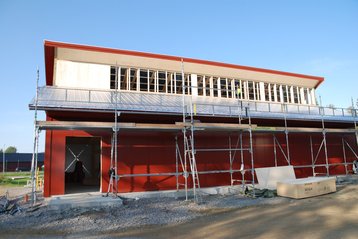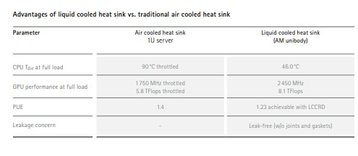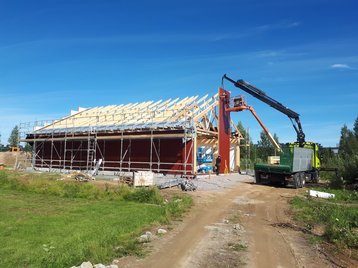This feature appeared in the April issue of DCD Magazine. Subscribe for free today.
As we touched down at Luleå Airport, the pilot cheerfully informed us that the temperature outside was -26°C (-14.8°F). That’s cold, even by Swedish standards. I’ve braved this weather to see Boden Type Data Center One - an EU-funded effort to build the world’s most efficient data center.
The project is part of Horizon 2020, a €77 billion ($87bn) research and innovation program aimed at securing Europe's competitiveness on the global stage. This is the eighth such program to take place since 1984. A large proportion of its initiatives are focused on cleantech and sustainability - and since data centers are responsible for anywhere between two and five percent of global electricity consumption, the industry is an obvious target for European policy-makers.
The prototype 500kW facility in the small town of Boden uses every trick in the book to lower its environmental impact: it runs on renewable energy and doesn’t have batteries or gensets. The data center relies on a combination of free and evaporative cooling with no need for refrigerants, and uses low-carbon, locally-sourced building materials.
Despite its small size, the project borrows design elements from hyperscale data centers, like slab concrete floors (rather than raised tiles), and a lack of plenum - instead, there's a version of the ‘chicken coop’ ventilation design, originally made famous by Yahoo. The first batch of servers housed in the facility was previously used by Facebook, and arrived pre-packaged in a ‘rack and roll’ configuration.
There are sensor arrays deployed throughout the building - collecting extensive data for analysis is one of the objectives of the project. But the main goal is to see if it's possible to build a data center that enjoys the cost benefits of hyperscale facilities, but comes in any size.
Pushing efficiency benchmarks
"What we are doing with this project is we are creating a very efficient, and therefore low cost, operating system, we are creating a very low cost building system, which is going to enable the little guys," said Alan Beresford, managing director of British evaporative cooling specialist EcoCooling, at the Boden Type inauguration event. “By little, I mean truly small operators, compared to the world of multi-gigawatt operators: less than 100kW.”
In line with Horizon 2020 requirements for cross-border cooperation, the project brings together organizations from four European countries; it's a collaboration between Boden Business Agency (Sweden), engineering firm H1 Systems (Hungary), EcoCooling (UK), and two research organizations - Fraunhofer IOSB (Germany) and RISE SICS North (Sweden).
Work on the project kicked off in October 2017. BBA was responsible for things like planning permissions and negotiations with local politicians; H1 Systems managed the construction work; EcoCooling contributed its proprietary free cooling tech; Fraunhofer designed synthetic workloads to put the facility through its paces, while RISE was tasked with monitoring, data collection and analysis.
Like the buildings around it, the exterior of the data center is painted deep red: the color is known as Falu red, after the copper mine in the nearby town of Falun. Inside, there are three data halls – the first has been outfitted with two rows of Open Compute Project racks, stacked with 180 of Facebook's simplified servers. This is where Fraunhofer runs its test workloads - currently modeled on the data output of a smart city, namely, Hamburg.
The second hall - still empty - was designed for high-density IT equipment, and will be used for demanding academic research and 3D rendering.
The third hall hosts empty shelves. These were specifically created for cryptocurrency mining equipment, but with the bitcoin market experiencing what’s been termed a ‘crypto winter,’ it’s not clear whether it will ever get to serve its original purpose. The ultra-high density specifications could be even more useful for new types of hardware - like FPGAs or ASICs used in machine learning.
The building was ready in less than five months, on par with some of the fastest prefabricated data center operations out there. Beresford said that this approach to construction could create a new type of data center campus, essentially working as a trailer park: just come in, stand up a facility in a few months, plug in power and water, and it's ready.
Everything inside Boden Type is instrumented for fine-grained control and data acquisition. According to Dr Jon Summers, a specialist in fluid mechanics at RISE, the facility picks up around 500 data points every second.
"What we would like to do is experiment with the fan controllers," Summers explained. "The thing is, not all servers are doing the same work. When you have a mixture [of workloads], you are getting different Delta-Ts, so if we could change the fan speeds to get the same Delta-T irrespective of the workload, that would be quite an innovation.
"And if we can get the control systems between the IT and the cooling system to talk about this, then we might have a chance of showing how we can do holistic control across the entire data center."
The prototype facility is not perfect for every task: its remote location and the lack of traditional redundancy features means it's mostly suitable for non-mission critical, yet power-intensive workloads. At the moment, whatever redundancy there is, is achieved through software - but the creators of the design say it could be easily adapted to include UPS and gensets, and possibly even shape up for a Tier certificate.
European expansion
But why should anyone outside of Sweden care about something that happens in Boden? This is where the second part of the project comes in: the idea is to codify and export the design, making it deployable not just in the Nordics, but anywhere in Europe, in a variety of configurations.
Technically, the customer here is the European Commission; the project sets a requirement of an average annual PUE of 1.1, but power usage effectiveness depends strongly on location. In Boden’s climate, the actual figures are apparently much, much lower, and the real-world performance will be confirmed after running extensive benchmarks over the next few months.
"If people embrace some of these techniques we are demonstrating here, then there is the potential to reduce the western world's electricity use by one or two percent. That's a truly massive potential impact. This is the starting point," Beresford said.
You might think that a government-sponsored data center design would be no match for experiments funded by the private sector. But the amount of investment required is minuscule, especially on a European scale. For just €3 million ($3.41m), the EU is getting a fully functioning 500kW research facility with impressive efficiency credentials, and that's a good deal.
"With projects such as Boden Type DC we are trying to push forward the current benchmarking and metrics of energy efficiency," said Pau-Rey García, project advisor on Horizon 2020 energy initiatives. "Hopefully soon, Boden Type project will reach new levels of efficiency, and will be a perfect lighthouse project, delivering concrete and useful results for the community in a highly competitive and fast-growing sector."
A short guide to creating a data center destination
Boden is an industrial town in the far north of Sweden, close to the Arctic Circle. Throughout its recent history, the municipality served as an important mining hub; it also hosted Sweden’s largest military base, intended to protect the country against a possible Russian aggression.
But local mines and ore fields replaced people with machinery, and the size of the army was reduced, leaving Boden in a state of decline, like so many other provincial towns – and then data centers came along. "We are turning former military airfields and hangars into a home for digital services," Claes Nordmarkas, Mayor of Boden, said at the launch of Boden DC Type One.
It would be fair to say that the rebirth of Boden started with Facebook, and its decision, back in 2011, to open the company’s first European data center in Luleå. What attracted the American company to the region was the abundance of renewable power.
There are 13 hydroelectric dams crossing the nearby Luleå River, producing around four gigawatts of power - and no matter how hard the local communities try to use it all, they are left with a surplus of more than two gigawatts. I was told that the river essentially serves as a giant battery for the entire region – not in the sense of storing power, but as a demand response and frequency regulation mechanism, keeping the local grid at rock-solid 50Hz. The last grid-level outage here happened in the 1970s.
The second reason for Facebook’s decision was staff: just around 80,000 people live in the region, but 10,000 of them are students at the Luleå University of Technology, offering a steady supply of skilled workforce.
Other benefits of the region include sub-arctic climate, stable political situation and some of Europe's lowest taxes on electricity consumed by data centers. Recognizing latent potential, Boden Business Agency (BBA) made a speculative investment into a 200MW substation and started promoting the town as a data center hub.
Facebook was followed by a number of smaller data center operators, like colocation providers Hydro66 and Fortlax, and several cryptocurrency mining ventures. BBA also got involved in Node Pole - an initiative launched in 2011 to offer plots of industrial land near Boden, pre-approved for redevelopment into data centers, complete with power and network connectivity.
A few years later, two local power companies realized that, rather than selling their excess electricity abroad and incurring transmission losses, they should attract large electricity consumers to the North of Sweden: in 2016, Node Pole was acquired by Vattenfall and Skellefteå Kraft, and they have since expanded the initiative to include not just sites around Boden and Luleå, but across the country.
Another catalyst for Boden's data center fortunes was the establishment of a local chapter of the RISE Research Institutes of Sweden in Luleå.
RISE SICS North, led by Professor Tor Björn Minde - who also serves as head of research strategy at Ericsson Research - lives and breathes data centers. Among the things they have here is a unique wind tunnel built to analyze server ventilation, and a massive plexiglass conservatory for airflow experiments. You can see an assortment of metal boxes filled with a viscous liquid in the corner - students have been building liquid cooling enclosures. The sensor arrays used in Boden DC Type One to track temperature and other environmental factors were created by the staff of RISE SICS North.
"To get research going you need money. And how do you get money? You need companies. And how do you attract companies? OK, let's build a unique test facility that you can't find anywhere else. We started in 2015, and in 2016 we started the lab," Minde told DCD. Today, RISE SICS North employs 20 people.
"Everything we do here is applied research," said Dr Jon Summers, scientific lead at RISE, who started working in Boden after spending 27 years at the University of Leeds in the UK. "It's the whole stack. From the infrastructure side, we're looking from the ground to the cloud, or from the chip to the chiller.
"The key thing we have here is we collect a lot of data, and you can use analytics to demonstrate efficiency. We use the same kind of monitoring technology that we put together in here - which is built on open source software - we use that in Boden [project]."
Participation in Boden Type DC One was an especially valuable opportunity because of all the data that could inform future research at RISE: "It's very difficult to get a hold of data from live data centers - nobody will give you access to their data," Summers said.
While the Boden Type project is waiting for results, BBA continues to position the town as a prime data center location. The latest designated data center zone is Svartbyn, and a sub-station is already under construction. The agency says it has 200-300MW of potential power capacity up for grabs – and more in the pipeline. Right now, the land is just pine forest covered by snow, but soon, it could house an assortment of cloud, colocation and hosting facilities.
"We think that the [Boden Type DC One] project has found the right home here in Boden, being a data center growth area at the moment, and - with the Svartbyn investment - even more so in the future," the Mayor said.
The municipality has ambitious plans: it wants to attract not just data centers, but also data-intensive industries. Earlier this year, Boden got its own small film studio, called Studio Nord, and there’s hope for 3D and animation rendering workloads; there’s also a growing game developer community, with professional education opportunities, and even a local e-sports team.
The small team of public servants hopes to create an ecosystem – and is attempting to do this without handing out generous tax incentives, the way local governments sometimes do in other parts of the world.




